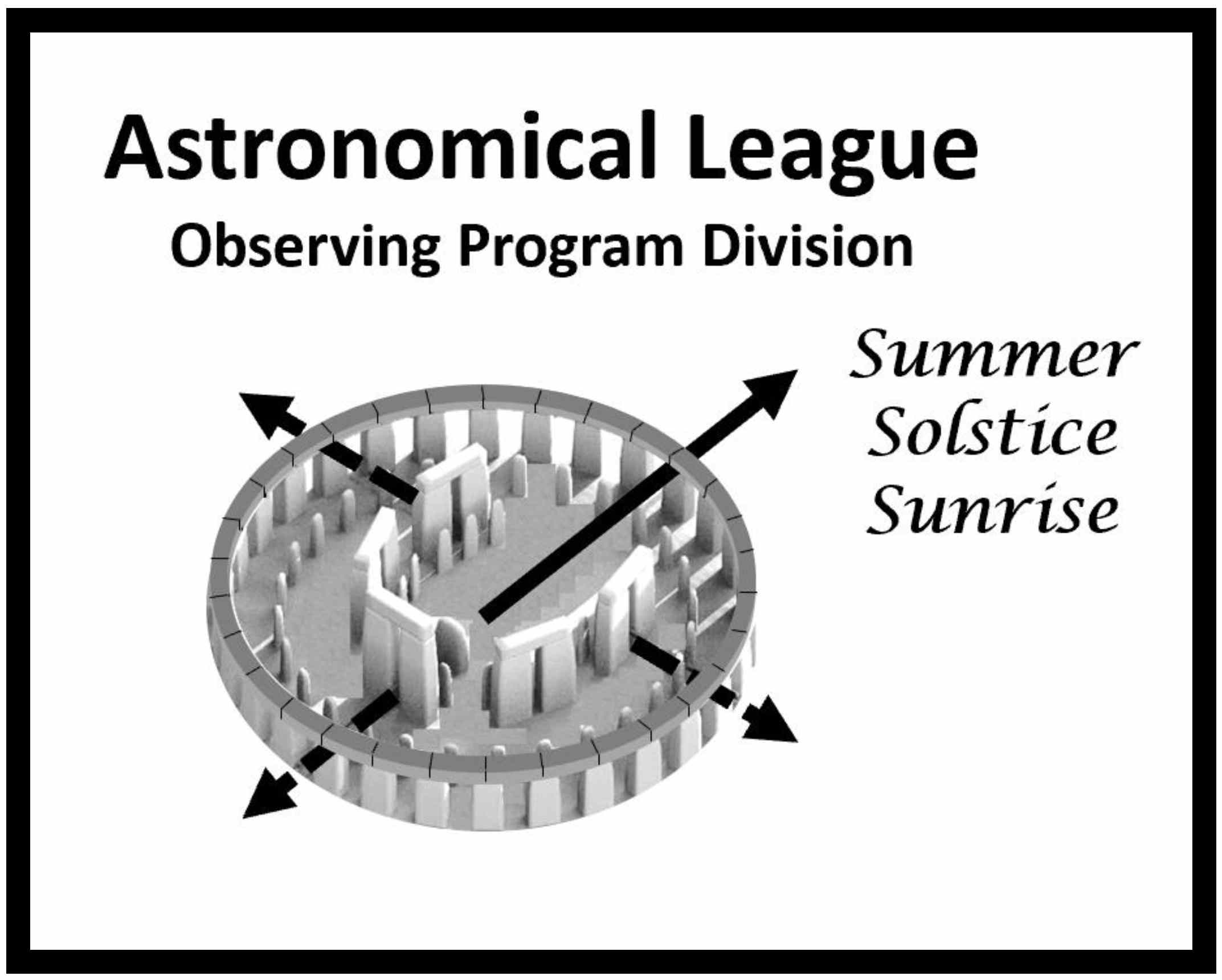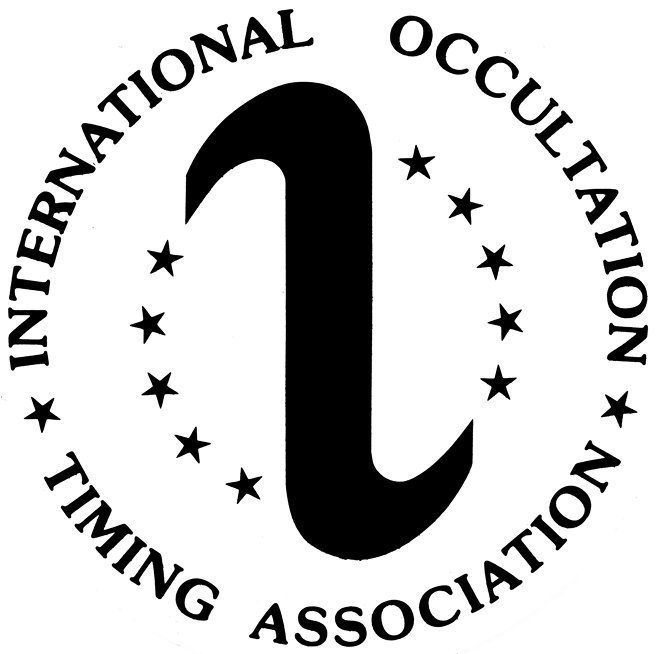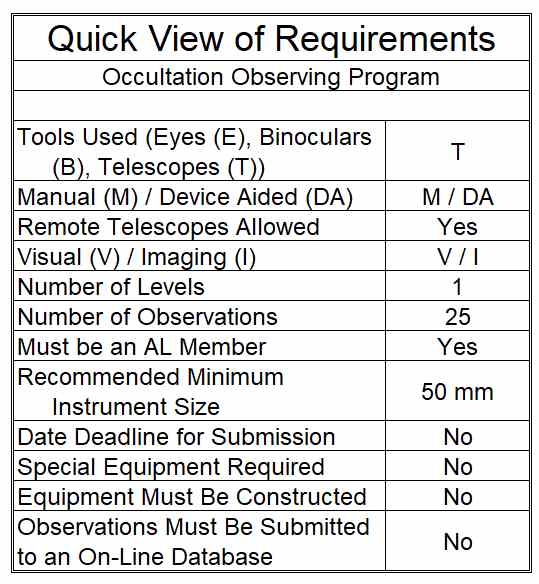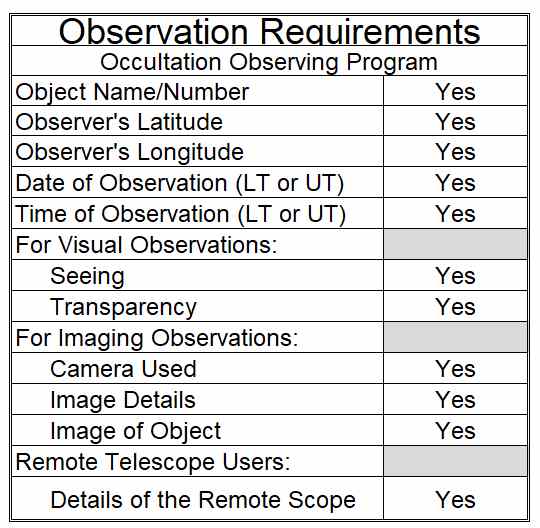Occultation Observing Program Coordinator:Steve Conard |
   |
Introduction
| Welcome to the Astronomical League’s Occultation Observing Program! An astronomical occultation (pronounced “occ-kull-tay-shun”) occurs when the Moon, an asteroid or another planetary body moves in front of a star, momentarily blocking its light. Occultations are fun to observe, but more importantly, they provide important scientific data on the occulting body, the occulted star or sometimes both! It is exciting to watch a star vanish and return from behind a lunar mountain, or to see the star disappear for several seconds as an asteroid passes in front of it. Anyone with a small telescope, tape recorder or camcorder and shortwave radio can make valuable scientific observations to help determine the size and shape of asteroids and to aid in new discoveries about these mysterious objects, including some of the elusive small moons that orbit them.
Occultation observations have been used for hundreds of years by sailors to determine time and their position at sea. More recently, in 1985 Pluto’s atmosphere was discovered by the occultation technique and in March 1977 the occultation of a bright star by the planet Uranus resulted in the discovery of its ring system. The novice observer will find the basics of occultations easy to understand, including how to observe and record them accurately using simple, inexpensive equipment. Advanced observers will find video methods of recording occultations extremely accurate, including the use of GPS timing through video time inserters that can allow frame-by-frame analysis of observations and provide timings accurate to a few hundredths of a second. |
 |
Requirements and RulesThe Occultation Observing Program is supported by the International Occultation Timing Association (IOTA) and its worldwide sister organizations (Europe, United Kingdom, Australia/New Zealand, Japan, S. Asia/India, Mexico, Latin America, and South Africa). We are here to assist you. IOTA sponsors online Internet discussion groups and provides free occultation predictions and planning software. Observers are in contact with each other frequently, planning for the next occultation expedition or sharing ideas on new equipment, software and new techniques. IOTA and several of its individual members have web pages loaded with occultation information and methods, tips, software, predictions and results of observations. Links to these pages are below. This Observing Program will likely take between six months and one year to complete. It is an active Observing Program, meaning that the participant will have to remain aware of upcoming occultations, plan for them along with other IOTA members, and possibly travel short distances either to reach the area where the occultation will be visible or to evade clouds. To qualify for the AL’s Occultation Observing Program Pin, you need to be a member of the Astronomical League in good standing either through an affiliated astronomy club or as a Member-at-Large. |
 |
Each observation should include
- the object name
- date and time (local or UT)
- location (Latitude and Longitude)
- the sky conditions (Seeing and Transparency)
The Observing Program includes observations of the three types of occultations of most interest to scientists: asteroid occultations, total lunar occultations and grazing lunar occultations. Each is explained below, along with the requirements for observing that type of occultation.
| Type of Occultation | Observing Program Requirement |
| Asteroid occultations, where an asteroid (sometimes visible itself, sometimes not) passes in front of a star, casting a shadow the size of the asteroid onto Earth’s surface. Multiple observers typically align themselves so they see the star passing behind different areas of the asteroid, allowing several cross-sections to be measured. With enough cross-sections, an accurate estimate of the shape of the asteroid can be determined. These events are fairly rare and although the shadow path may be thousands of kilometers long it may be only a few kilometers wide (essentially the diameter of the asteroid itself). | Attempt and successfully observe, including submission of a report to the IOTA regional coordinator a total of 7 asteroid occultations. At least 1 of these must be a “positive” observation, a second must either be a positive or a negative that constrains other observers’ positive(s). The rest may be “negative” observations that support other observers’ positive observations. The timing of these observations must be referenced to either GPS or WWV universal time. Observations may be either visual or using video/imaging equipment. For 3 of these observations, the asteroid must be bright enough to be visible (in an eyepiece or in the imaging/video equipment), and either a sketch or image of the asteroid approaching and/or receding from the star with an arrow indicating the direction of motion should be submitted. |
| Total lunar occultations, where the dark leading edge of the waxing Moon covers (or the dark trailing edge of the waning moon uncovers) a star. In addition to improving our knowledge of the location of the star and the orbit of the Moon, this is a very powerful technique for identifying and studying close double (or multiple) star systems. These events are typically visible over large areas of the Earth’s surface and happen frequently each month. | Attempt and successfully observe, including submission of a report to the IOTA lunar occultation coordinator, for at least 15 total lunar occultations over at least 5 different dates, at least 1 of which must be for double stars that produce a stepped disappearance or reappearance and at least 3 must be reappearances. Each reported timing may be of the disappearance(s) or reappearance(s). The timing of these observations must be referenced to either GPS or WWV universal time. Observations may be either visual or using video/imaging equipment. |
| Grazing lunar occultations, where the north or south limb of the eastward-orbiting Moon just grazes a star. The light of the star is frequently seen to wink off and on several times as it is periodically blocked by the mountains of the Moon. The area where these events can be seen may be quite narrow, and a difference in position of only a few hundred yards on Earth can materially change the pattern of disappearances and reappearances observed. Until the Kaguya satellite mapped the moon’s surface in detail, these measurements were the only way to learn the geography of the lunar limb area. | Attempt and successfully observe, including submission of a report to the IOTA lunar occultation coordinator, for at least 3 grazing lunar occultations, at least 1 of which must produce multiple disappearances or reappearances. Each reported timing must be of the disappearance(s) and reappearance(s). The timing of these observations must be referenced to either GPS or WWV universal time. Observations may be either visual or using video/imaging equipment. |
Additionally, for all the above, a complete description of how the timing was done (including hardware used) and what the expected error on the measurements is should be included. (Documentation is available to help you determine this information.) Also note how each prediction was obtained, and how the results of the observation compared to the prediction. For video-recorded observations, a description of how the data analysis was performed is also required.
Special Equipment Required:
At a minimum for visual observations, a way to obtain time referenced to either WWV radio or GPS universal time is required. Typically, a short-wave radio capable of receiving WWV and a voice recorder or stopwatch is the most economical way to achieve the necessary timing accuracy. For video recorded observations, recording WWV in the audio track of the video file is the most economical method. Small telescopes (in the 80mm range) should be sufficient although longer focal-length scopes may help with grazes and lunar occultations that occur nearer to the bright limb of the moon by allowing higher magnification to keep the bright areas out of the field of view.
Submitting for Certification
This certification is available to members of the Astronomical League, either through their local astronomical society or as members at large. If you are not a member and would like to become one, check with your local astronomical society, search for a local society on the Astronomical League Website, or join as a Member-at-Large.
Upon completion of the requirements listed above, please submit your completed documentation to the Occultation Observing Program Coordinator. Be sure to include your name, mailing address, email address, phone number, society affiliation, and to whom the certification should be sent.
Occultation Observing Program Coordinator:Steve Conard |
 |
Upon verification of your submission and of your active membership in the Astronomical League, your recognition (certificate, pin, etc.) will be sent to you or to the awards coordinator for your society, as you specified. Your name will also appear in an upcoming issue of the Reflector magazine and in the Astronomical League’s online database. Congratulations. Good luck with your next observing challenge.
Notes:
- Citizen Science: If you enjoyed this Observing Program, and look forward to doing more observations to submit to the national or international database, then we invite you to participate in the Astronomical League’s Citizen Science Program. This is an extension of this Observing Program and only requires you to do what you have been doing; observing and submitting those observations.
Links:
- An Introduction to Occultations: PDF file
- Find your Observing Program Award
Recommended Reading:
- International Occultation Timing Association (IOTA) Discussion Group: https://groups.io/g/IOTAoccultations for announcements, discussions, and reporting.
- Introduction to Occultations:http://www.poyntsource.com/IOTAmanual/Introduction_to_Occultations.htm, 11-page summary introducing the main concepts of occultations – total, grazing, asteroidal, etc. Covers hardware and useful software.
Detailed Predictions and Resources:
- http://www.asteroidoccultation.com/ – Online resources for predictions of asteroidal occultations, results of previous occultation measurements, understanding how to use the predictions, how to report observations, how to use the equipment, how and where to obtain free software tools, useful weather forecasting sites, YouTube videos of previous occultations, FAQ’s, and much more.
- Pathmaps, Observer’s Manual: http://www.poyntsource.com/New/ – Pathmaps; Regional Events; Links to download IOTA Observers manual and flyer “Why Occultations?”; Current worldwide asteroid event details with interactive maps; Future asteroid event details to 2015; Detailed predictions for the SF Bay Area; Videos of many past asteroid and lunar occultations; much more.
- IOTA’s Administrative Site:http://www.lunar-occultations.com/iota/ – IOTA main page with upcoming events, predictions for the current year, many helpful links, more software links, basics of total occultations, basics of grazing occultations, regional information, how to use video for occultation recording, IOTA administrative information, links to International associate organizations, and much more.



